Email marketing is one of the best ways to grow your business and reach your target audience.
But with so many email marketing platforms available, how do you choose the best one for your needs?
In this article, we’ll compare two popular options: ActiveCampaign and GetResponse.
These two powerful email marketing tools offer more than just sending emails. They provide landing pages, automation, segmentation, analytics, and excellent customer support.
However, some differences might make one of them a better fit for your goals and budget.
In this post, we’ll review their features and pricing to help you decide which one offers better value for money.
Let’s dive right in.
ActiveCampaign vs GetResponse: Quick overview
While ActiveCampaign and GetResponse have several standard features, they offer unique strengths to cater to different business needs.
ActiveCampaign enjoys an impressive 4.5-star rating on Shopify. This reflects its popularity and customer satisfaction among 180,000 users.
In contrast, GetResponse holds a 1.5-star rating on Shopify. This evaluation may raise concerns about its customer service and offerings. But we have tested it out and can assure you it’s way better than this rating indicates. Otherwise, GetResponse wouldn’t grow the army of 350,000 customers.
Still, let’s establish whether GetResponse or ActiveCampaign meets your needs.
To do so, we’ll present an overview of their main features.
As per this table, both ActiveCampaign and GetResponse are feature-rich tools. However, there are some differences in their approach to certain features.
Let’s compare GetResponse vs ActiveCampaign to understand what makes them unique.
GetResponse vs ActiveCampaign: Feature by feature
Your email marketing campaigns will improve whether you choose ActiveCampaign or GetResponse.
But the choice between the two depends on your requirements and priorities.
Let’s find out which is GetResponse or ActiveCampaign.
Ease of getting started
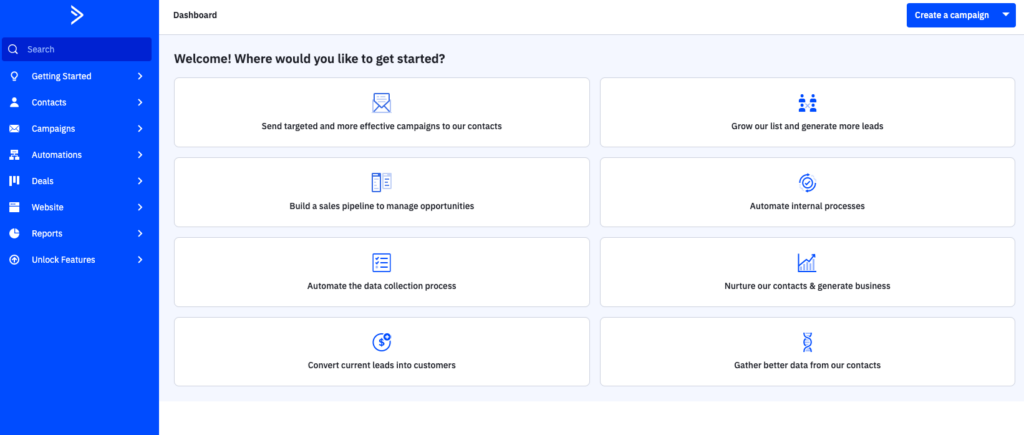
Both ActiveCampaign and GetResponse offer user-friendly, industry-standard signup processes. It’s hassle-free through the ecommerce platform but involves a slightly longer process with several key business questions on the homepage.
The main difference is that ActiveCampaign requires your credit card for signup, while GetResponse doesn’t.
Finding the main settings and changing the sender’s email address on both platforms is straightforward. The interfaces and navigation are intuitive and well-organized.
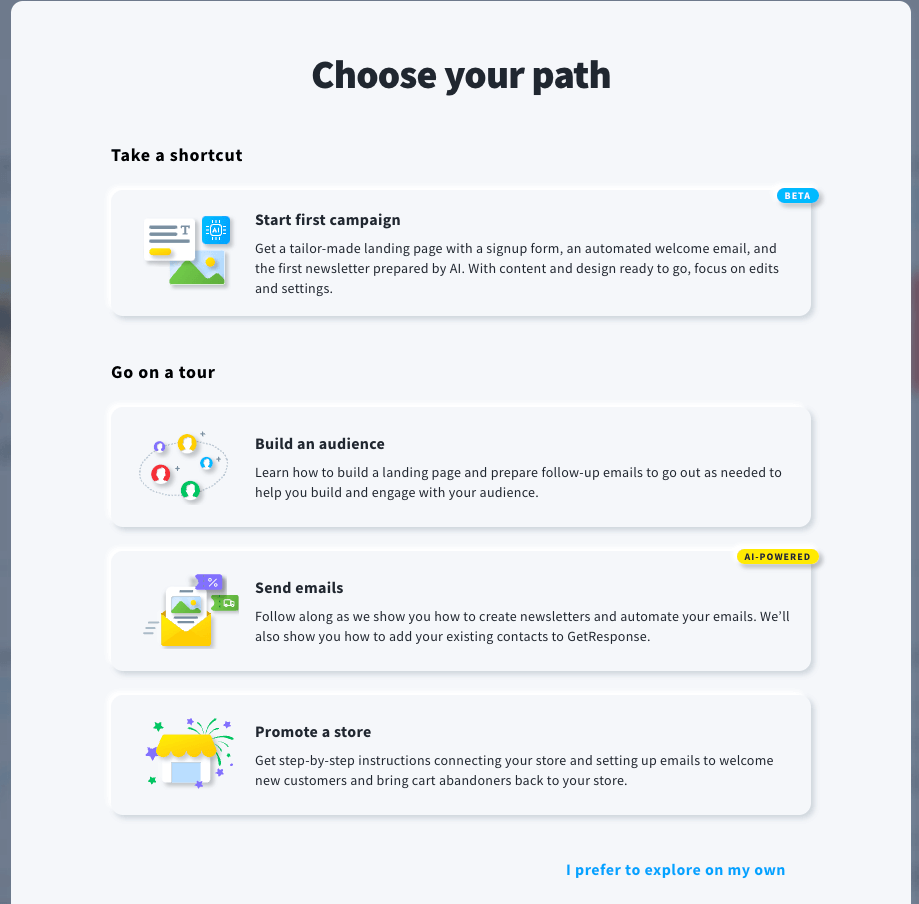
Let’s consider first impressions and clarity of navigation. ActiveCampaign’s interface appears clean and well-organized. It provides a “getting started” wizard. There are also extended submenus for easy access to various options.
This platform offers a wide range of advanced settings that might overwhelm non-tech-savvy users.
On the other hand, GetResponse’s interface and navigation are highly intuitive. They feature well-thought-out menu logic. Although GetResponse is a very comprehensive platform, it doesn’t feel so overwhelming due to its interface.
GetResponse edges ahead with its straightforward signup process and highly intuitive interface. It’s also more accessible, while ActiveCampaign’s unique features may need technical expertise.
Building an email campaign
Creating email campaigns using either ActiveCampaign or GetResponse is a breeze. 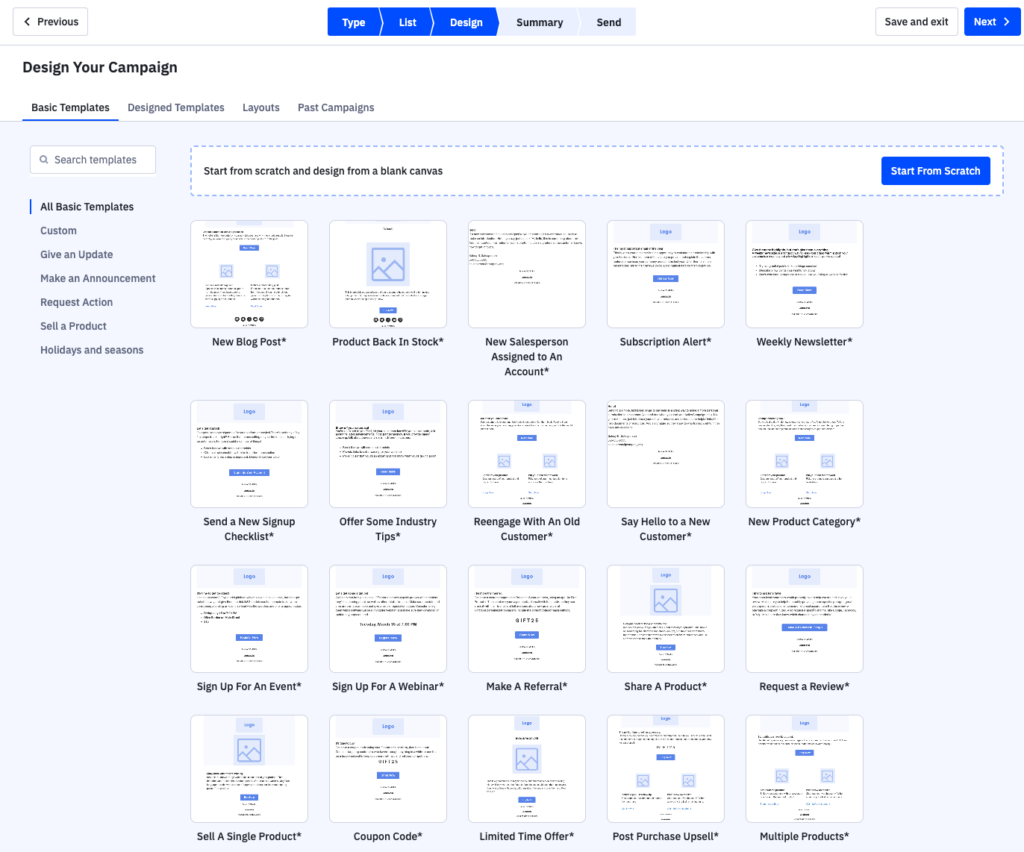 Both platforms offer intuitive and straight-forward email-building wizards.
Both platforms offer intuitive and straight-forward email-building wizards.
ActiveCampaign’s email builder allows drag-and-drop functionality and standard email-building content blocks. Still, it could be more intuitive than other email marketing solutions.
Meanwhile, GetResponse’s editor is well-organized and user-friendly, with basic content elements. It also has helpful ecommerce blocks for product recommendations and unique discount codes.
Regarding email types, GetResponse offers all essential categories. These include:
- Regular newsletters
- RSS campaigns
- Automations
- A/B tests
Meanwhile, ActiveCampaign offers very similar but more diversified types, such as:
- Standard
- Automated
- Date-based
- Split testing
- Autoresponders
- RSS triggered campaigns
We found it interesting that ActiveCampaign separates Autoresponder, Automated, and date-based campaigns. This is unique compared to other platforms.

Regarding email templates, both platforms offer extended libraries of 200+ email templates that vary by their style and purpose, but the vast majority of them are modern and nice.
Both platforms have good personalization options. Users can easily add customer data to subject lines and email content. GetResponse goes the extra mile by offering product recommendations for added customization.
ActiveCampaign includes “Message Variables” for time-saving personalization. There’s also a “free design service” for customized email templates to match a brand’s look and feel.
Meanwhile, GetResponse stands out with unique discount codes and AI-generated campaigns. These help streamline marketing efforts and save time.
Lastly, we found both platforms had some useful features missing. For instance, they lack image carousels and surveys.
GetResponse again excels with its more user-friendly and feature-rich email builder. Additionally, its unique discount codes and AI-generated campaigns offer valuable advantages.
Marketing automation
Both ActiveCampaign and GetResponse offer robust and feature-rich marketing automation solutions. They both can be sufficient for advanced marketing campaign implementation. They combine various channels and can cater to even big companies’ needs.
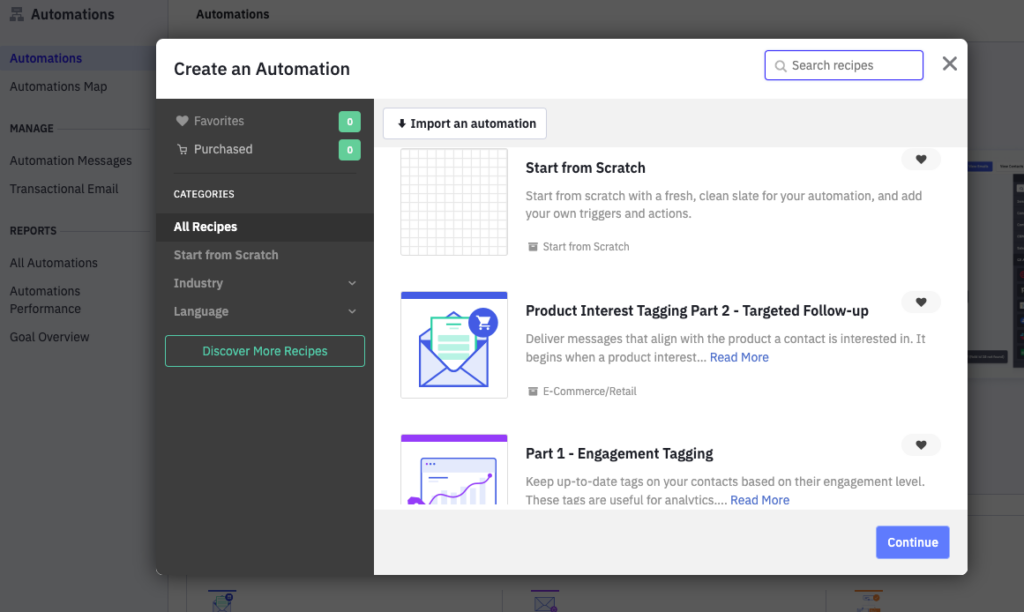
GetResponse supports push notifications. But with ActiveCampaign, users can seamlessly integrate various marketing channels, as well as:
- CRM
- Salesforce
- Send personalized 1-on-1 emails
Regarding pre-built workflows, ActiveCampaign has over 850 automation recipes. These suit different customer behavior scenarios. They also offer hundreds of ready-to-use automation logic options.
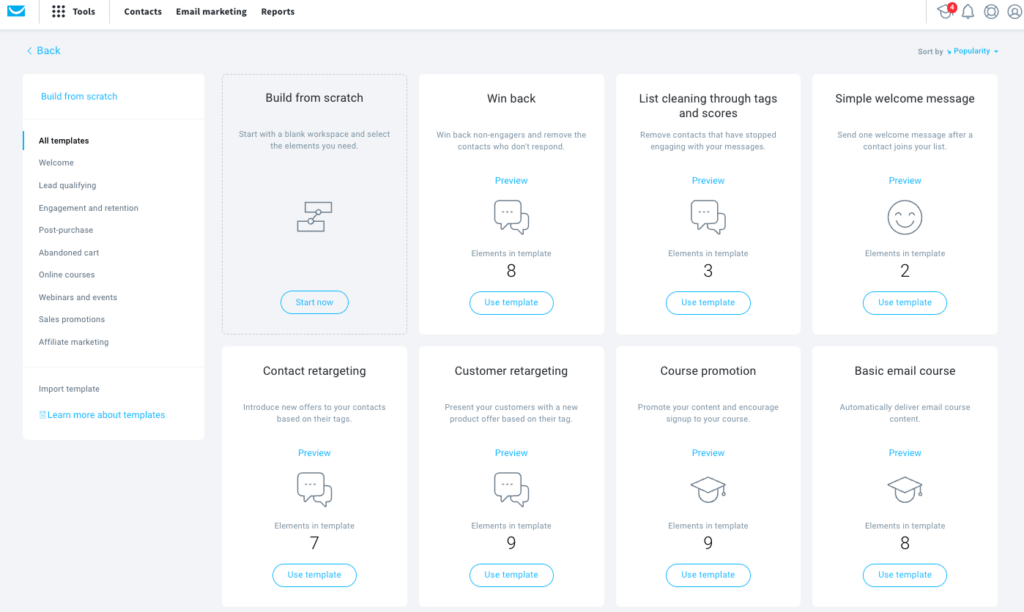
Meanwhile, GetResponse provides 43 pre-built automation workflows tailored for common ecommerce cases. They come with a diverse set of conditions and tags, enabling automation based on:
- Purchases
- Email activity
- Personal details
- Customer behavior
But does GetResponse or ActiveCampaign have any downsides?
It seems to us that ActiveCampaign’s many options might overwhelm some users. Additionally, the platform might require a learning curve to maximize its potential.
GetResponse, on the other hand, only unlocks advanced features on the highest-tier plans. These features include product recommendations and abandoned cart trigger emails.
This round of GetResponse vs ActiveCampaign review goes to ActiveCampaign. It offers more pre-built workflows in number and customization options.
Signup forms and landing pages
Now, let’s see how ActiveCampaign vs GetResponse compare in terms of signup forms and landing pages.
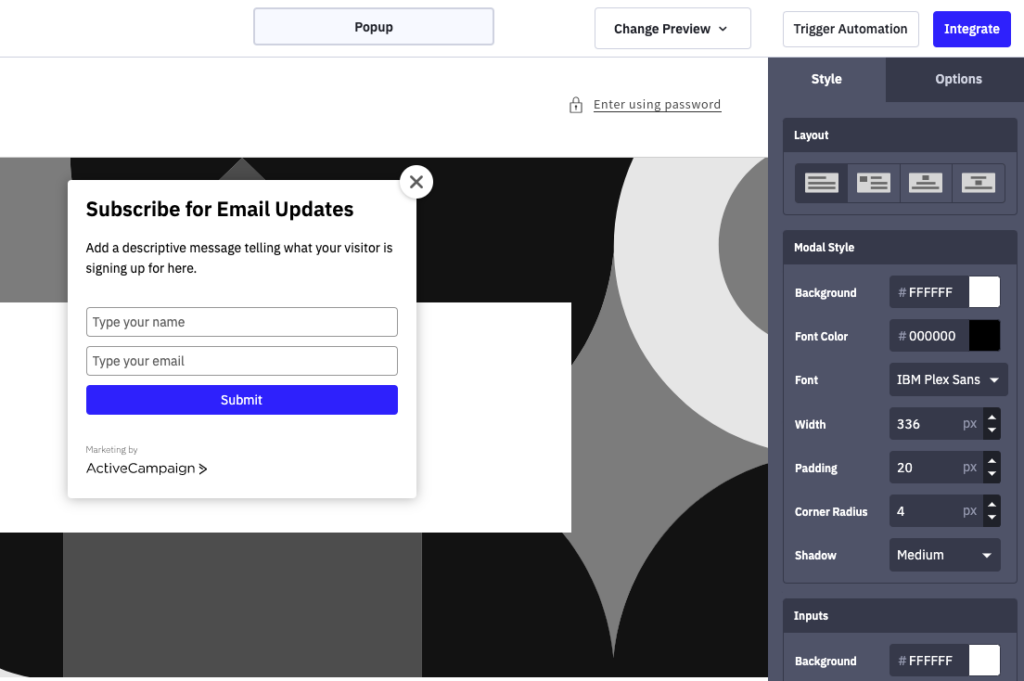
ActiveCampaign offers a range of options, including:
- Inline
- Popup
- Floating box
- Floating bar forms.
However, the platform lacks ready-to-use templates for these forms. This means users must create them from scratch or customize available layouts.

Conversely, GetResponse has over 150 pre-built designs for popups and signup forms. These designs cover various purposes, such as:
- List building
- Sales promotion
- Feedback collection
GetResponse users get ready-to-use options, adaptable to match brand colors and design preferences. Their signup forms and popups also have a modern look.
Meanwhile, ActiveCampaign’s forms and layouts appear basic. But they’re also easily customizable to match brand colors and design preferences.
Regarding analytics, both ActiveCampaign and GetResponse deliver valuable insights. ActiveCampaign shows the number of:
- Total entries
- New contacts created
- Deals created
This gives users a comprehensive view of signup form performance.
In comparison, GetResponse goes a step further. It provides detailed analytics on signup form performance, including:
- CTR
- Views
- Clicks
- Leads
- Insights by device and country
Moving on to landing pages, both ActiveCampaign and GetResponse offer this feature.
However, it’s only available for Plus plan users and higher in ActiveCampaign. Here, users can track page views, conversions, and conversion rates. These are valuable metrics for assessing landing page success.
On the other hand, GetResponse has an extensive library of excellent designs for landing pages. The platform allows easy customization using a drag-and-drop editor. Users can create landing pages from ready-made templates or build one from scratch.
GetResponse emerges as the winner in this category. It shines with its extensive library of modern, pre-built designs and easy adaptability.
Segmentation
Both platforms offer powerful and extensive capabilities to create targeted audience segments for B2C and B2B businesses.
However, neither provides ready-to-go audiences or pre-built segments. This means users must build segments from scratch based on their specific criteria.
ActiveCampaign users can segment contacts based on criteria like:
- Contact details
- Customer email actions
- Geography
- Attribution
- Site and event data
- Account details
- Shopping behavior
- Deal details, and
- Custom deal fields
These comprehensive options allow marketers to fine-tune their target audience. They also secure the delivery of personalized content.
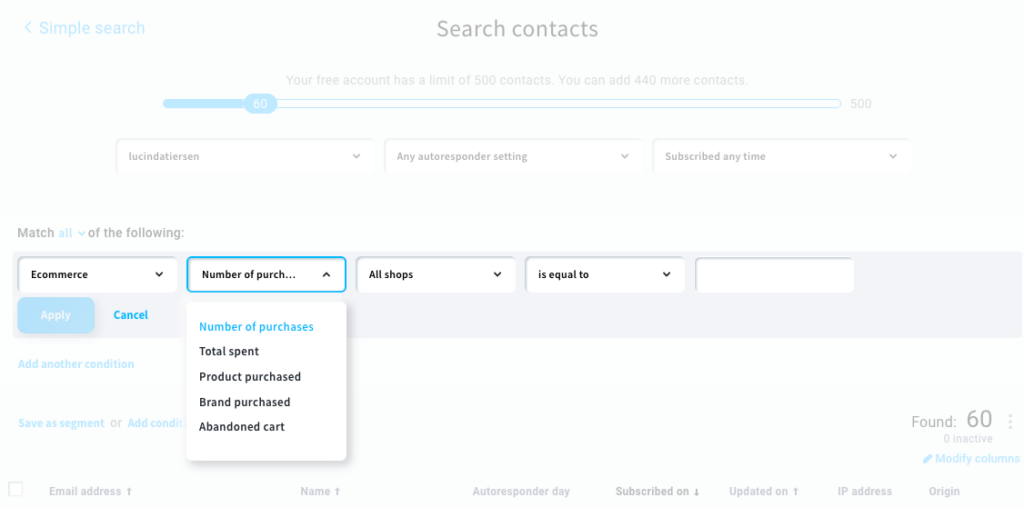
Meanwhile, GetResponse users can segment contacts based on:
- Contact details
- Contact actions
- Geolocation
- Scoring
- Tags
- Consent fields
- Ecommerce behavior
- Conversion funnel
- Events
- Lead magnets
However, we didn’t find onsite behavior criteria for segmentation. This criterion can provide valuable insights for businesses focusing on website engagement.
This round pitting ActiveCampaign vs GetResponse results in a tie. While both platforms lack pre-built segments, they provide powerful segmentation capabilities.
Analytics
Having tied in segmentation, how will ActiveCampaign vs GetResponse do in analytics?
Both ActiveCampaign and GetResponse offer valuable reporting options. Users can track and measure their email marketing efforts with their invaluable analytics.
Regarding available reports, both tools have options ranging from basic to advanced.
On Active campaign, you can see site tracking, campaign and automation engagement reports, link and event tracking.
GetResponse offers default campaign engagement tracking like opens and clicks.
As a drawback, they both offer basic campaign engagement reports on the lower-tier plans, and for advanced insights, like social media, store performance, ecommerce, and custom reports, you have to upgrade to the higher-tier plans.
Yet another tie between ActiveCampaign and GetResponse. Both provide comprehensive reports. But they also limit the advanced ones to higher-tier plans.
Customer support
ActiveCampaign and GetResponse are comprehensive platforms with an extensive list of features. Let’s see how they can help you figure them out.
First of all, both platforms offer chat and email support 24/7. We found them to be responsive and helpful.
When it comes to phone support, ActiveCampaign doesn’t offer this option. This can be a drawback for users who prefer direct communication. Meanwhile, GetResponse has phone support. However, it limits it to the highest-tier users, locking out lower-tier users.
We also noted that GetResponse doesn’t support users on its free plan.
Like many industry players, ActiveCampaign and GetResponse provide extensive resources and tutorials to help their clients help themselves independently.
It’s a tie. Most importantly, you can reach out to service providers whenever you need, without waiting for working hours.
Integrations
Both ActiveCampaign and GetResponse offer a wide range of integrations. These enhance the functionality of their email marketing platforms.
ActiveCampaign provides an impressive selection of over 930+ native integration possibilities. These offer users vast options to connect with third-party apps and services.
GetResponse also offers a substantial piece of over 200 integrations. Like with ActiveCampaign, these help users complement their email marketing efforts.
Both ActiveCampaign and GetResponse integrate with popular platforms, including:
- PayPal
- Shopify
- MailOptin
- Bigcommerce
- Google Analytics
- WordPress
The two also further extend their integration capabilities by seamlessly connecting with Zapier. This popular automation tool grants access to an even larger pool of integrations.
ActiveCampaign wins this round, pitting GetResponse vs ActiveCampaign. Its 930+ integrations simply make it the go-to choice.
Compatibility with other marketing channels
Both ActiveCampaign and GetResponse offer several options to reach and engage with audiences.
Firstly, ActiveCampaign and GetResponse provide SMS marketing as an add-on feature. This feature allows users to send text messages as part of their campaigns.
ActiveCampaign offers SMS marketing at an extra cost for users on the Plus plan and above. However, GetResponse limits this feature to users on the MAX plan.
Secondly, ActiveCampaign and GetResponse support web push notifications. While this channel is rarely used as a stand-alone method, it greatly enhances email and SMS campaigns as well as marketing automation workflows.
Both platforms also support Facebook and Google ads, live chat, and more.
Both platforms shine in regards to compatibility with other marketing channels.
Price Comparison
We’re now drawing toward the conclusion of our ActiveCampaign vs GetResponse comparison. But before we wrap up, let’s dig into the details of their free and paid plans.
Free plans comparison
ActiveCampaign doesn’t offer a free plan to users. Instead, it has a 14-day free trial to allow users to explore the platform’s capabilities. Trial features are comparable to the Marketing and Sales Bundle Professional tier.
Still, some limitations apply during the trial period. For instance, users can only upload up to 100 contacts. You’re also limited to 100 email sends.
Meanwhile, GetResponse offers quite a generous free plan. It gives users the ability to send up to 2,500 emails per month. Furthermore, you get access to:
- One website
- One landing page
- Up to 500 contacts
There’s an exciting thing about the 500 contacts GetResponse free account users. Removed and unconfirmed contacts don’t count toward the list size.
GetResponse also allows free users to test and use premium account features for 30 days. These include:
- Conducting webinars
- Scheduling newsletters
- Sending autoresponders
- Using conversion funnels
- Publishing automation workflows
GetResponse looks confident about its ability to keep and convert Free plan users to paying customers.
Paid plans comparison
Both ActiveCampaign and GetResponse provide a range of paid plans.
ActiveCampaign’s paid plans are:
- Lite
- Plus
- Professional
- Enterprise
Meanwhile, GetResponse’s plans are:
- Email Marketing
- Marketing Automation
- Ecommerce Marketing
- MAX
Here’s a quick ActiveCampaign vs GetResponse pricing comparison.
With ActiveCampaign, you get customized plans for anything above 50,000 subscribers. The same applies if you choose the Enterprise plan. On the other hand, GetResponse offers custom pricing for its MAX paid plan.
ActiveCampaign’s Lite plan is the lowest-tier option. The Lite plan includes email campaigns, forms, and basic marketing automation. However, certain essential features are locked in this plan, including:
- Ecommerce platform integrations
- SMS channel
- Lead scoring
- Split automation
A more comprehensive set of features is only available in higher-tier plans, such as the Plus plan. But even this plan has some functionalities locked. These include predictive sending, split automation, and custom reports.
As for GetResponse, its cheaper plans may be lower compared to other platforms. But some crucial features are available only on the highest-tier plans. Examples include abandoned cart automation and ecommerce tracking.
Plus, you can send unlimited emails with ActiveCampaign and GetResponse. However, ActiveCampaign has a condition. It only offers unlimited sending in paid plans up to 250,000 contacts.
So, which is better, GetResponse or ActiveCampaign?
When comparing the free plans, GetResponse stands out with its more generous offering.
But when it comes to paid plans, the decision becomes trickier. Both solutions aren’t cheap. It’s advisable to consider the feature requirements suitable for your business. Additionally, look at how well each platform aligns with those needs.
GetResponse vs ActiveCampaign: Which one wins?
Finally, let’s summarize the features and pricing of ActiveCampaign vs GetResponse.
4.1
4.6
1,000 subscribers – $39
5,000 subscribers – $99
10,000 subscribers – $174
50,000 subscribers – $486
100,000 subscribers – custom price
1,000 subscribers – $19
5,000 subscribers – $54
10,000 subscribers – $79
50,000 subscribers – $299
100,000 – $539
– Paid plans only
– 14-day free trial
– 2,500 emails per month
– Email templates
– Basic email campaign tracking
– Very basic segmentation
– Signup forms but no popups
– Very good marketing automation features
– Good email templates
– Extended monitoring and reporting capabilities
– Very broad functionality, including CRM, transactional emails, sales funnels
– Very complete tool with lots of features
-Good email and signup form templates
– Affordable price
– Easy to use
– More expensive than similar tools
– Might be overwhelming for non-tech-savvy beginners or marketing beginners
– Ecommerce reports available on the higher tier plans only
– Signup forms don’t have templates
– Might be a bit overwhelming for beginners
– Ecommerce features available in the highest-tier only
– Well-established ecommerce businesses
– B2B companies
– Small and mid-size ecommerce businesses
– B2b companies
– Ecommerce beginners
– Non-profit organizations
– Solopreneurs
– Complete email marketing beginners
– Solopreneurs
– Non-profit organizations
– Bloggers
Both ActiveCampaign and GetResponse offer powerful email marketing solutions with unique strengths.
ActiveCampaign excels in advanced automation and customization, making it suitable for well-established businesses.
GetResponse stands out with user-friendly features and an abundance of beautiful templates for everything.
Ultimately, your choice depends on your specific needs, budget, and level of expertise.
Read full reviews
Related picks for you
Our team strives to be accurate and unbiased in reviewing email tools. However, we recognize that mistakes can happen, and it’s essential for us to stay up to date. If you come across any errors or things that need to be reviewed again, please let us know.




Leave a Reply